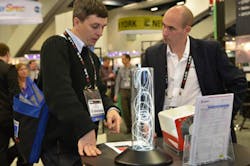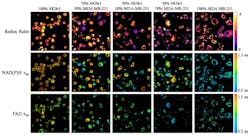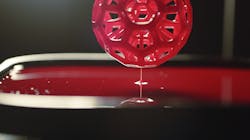Photonics West Preview: New opportunities and insights: SPIE Photonics West 2016
Continually evolving as the markets change, SPIE Photonics West 2016 presents a rewarding brew of products, market insights, and enlightening technical sessions. North America's leading optics and photonics conference and exhibition will again be held in the Moscone Convention Center in San Francisco—this year from February 13-18. The BiOS exhibition, with more than 200 exhibitors, runs from February 13-14, and the SPIE Photonics West exhibition with 1250 exhibitors is open from February 16-18, displaying products and offering networking across the spectrum (see Fig. 1).
The mainstay symposia are BiOS, LASE, and OPTO, complemented by three virtual Application Tracks that showcase papers from the symposia: Green Photonics, Translation Research, and 3D Printing. In addition, there are Panels on topics such as system design for laser materials processing, financing photonics businesses, and integrated photonics, as well as Special Events that include the popular SPIE Startup Challenge and Startup Alley (see http://spie.org/PW/special-events/Industry-Event).
On Wednesday evening, February 17, a gala dinner setting is where the winners of the annual PRISM Awards for innovative products will be announced—the list of finalists may be found on the SPIE Photonics West website (see www.photonicsprismaward.com).
BiOS
Before the main part of Photonics West, BiOS, the Biomedical Optics Symposium—described as "The world's largest biomedical optics and biophotonics exhibition"—will open Saturday, February 13. Presentations are organized into six tracks, one of which represents a consolidation of three conferences that ran in earlier years. This consolidated track, called Neurophotonics, Neurosurgery, and Optogenetics, represents one of the two key topics SPIE is highlighting for Photonics West: Neuroscience.
The Neuroscience conglomeration includes Clinical and Translational Neurophotonics (covering spectroscopy, tomography, microscopy, optical coherence tomography [OCT], and operative and post-op therapies), Neural Imaging and Sensing (with seven sessions on imaging and one on sensing), and the fascinating area of Optogenetics and Optical Manipulation.
Other BiOS tracks include Photonic Therapeutics and Diagnostics; Clinical Technologies and Systems; Tissue Optics, Laser-Tissue Interaction, and Tissue Engineering; Biomedical Spectroscopy, Microscopy, and Imaging; and Nano/Biophotonics. The latter will feature a keynote by Halina Rubinsztein-Dunlop (University of Queensland; Australia) on optical tweezer applications.
The 2016 BiOS symposium will feature two new conferences. One, titled Biophysics, Biology, and Biophotonics: the Crossroads, will include macromolecular crowding (described as a crucial, yet underappreciated, phenomenon); biological principles of therapeutic/diagnostic tech; nanoscale cell imaging; and methods for studying the cancer microenvironment. The other will highlight the implications of advances that enable generation of enormous image files. Called High-Speed Biomedical Imaging and Spectroscopy: Toward Big Data Instrumentation and Management, it will cover ultrafast, computational, high-speed nonlinear, and 4D imaging, along with light-sheet microscopy, imaging flow cytometry, and more.
OPTO
The OPTO plenary session on Monday will feature talks by Xiang Zhang of UC Berkeley on parity-time symmetry photonics (in which balanced gain and loss materials in photonics simulate quantum systems), with applications such as ring lasers and zero-reflection cavities; by Robert Boyd of the University of Ottawa (Canada) and the University of Rochester on quantum nonlinear optics, leading to secure communication systems based on the quantum states of light; and by Michael Liehr of the American Institute for Manufacturing of Integrated Photonics (U.S.) and SUNY Polytechnic Institute on merging photonics with nanophotonics, including technical goals, operational framework, near-term milestones, and opportunities for the photonics community.
Conference program tracks for OPTO include Optoelectronic Materials and Devices, Photonic Integration, Nanotechnologies in Photonics, MOEMS-MEMS in Photonics, Advanced Quantum and Optoelectronic Applications, Semiconductor Lasers and LEDs, Displays and Holography, and Optical Communications: Devices to Systems.
For example, under MOEMS-MEMS in Photonics Conference 9759 Session 2, Ion-Beam Fabrication for Nanophotonics, a group of researchers from various German institutions will talk about their investigation and optimization of grating ghosts in high-efficiency spectrometer gratings fabricated by e-beam lithography, in which they learned how to optimize the e-beam writing and stitching process to minimize the stray-light ghosts.
Under Vertical-Cavity Surface-Emitting Lasers XX (Conference 9766) Session 2, a group from Sandia National Labs and EIOS will describe single-frequency VCSELs for interferometric readout of MEMS sensors with resolutions of less than 1 nm, for sensors such as accelerometers, gyroscopes, and microphones. In Session 5, VCSEL Modulation and Characteristics, researchers from the U.S. Military Academy and Stanford University will discuss their beam-quality study for single-mode oxide-confined and photonic-crystal VCSELs. Here, high-quality, 850-nm-emitting VCSELs are used for optical data communications and interconnects.
Also, under Advanced Quantum and Optoelectronic Applications Conference 9763 Session 15, Theoretical Developments in Slow and Fast Light, Benjamin Solomon of the Xodus One Foundation will talk about photon probability control. Because photons are not affected by the presence of electric or magnetic fields, probability control—or the control of photon localization—requires other approaches such as vectoring and modulation. Solomon says that even quantum theory cannot explain how Nature implements probabilities, and so he proposes a control mechanism by rethinking the foundations of quantum theory.
LASE
Held on Wednesday, the LASE plenary session includes presentations by Philip Russell (see video) of the Max Planck Institute for the Science of Light and University of Erlangen-Nüremberg (both in Germany) on the emerging applications of photonic-crystal fibers (PCFs), including ultrafast spectrally bright deep- and vacuum-UV sources based on gas-filled hollow-core PCFs, generation of stable bright deep-UV supercontinuum light in PCF, orbital angular momentum (OAM)-birefringent helically twisted PCF, and light-driven optoacoustic devices; by Satoshi Kawata of Osaka University and RIKEN (both in Japan) called "Optical 3D Nano-fabrication: Drawing or Growing?" where he discusses various forms of nanofabrication, including two-photon polymerization, isomerization, and photoreduction, along with self-growth technology approaches; and by Scott Keeney of nLight on new applications of high-power semiconductor lasers that will disrupt the currently fragmented semiconductor-laser industry—in other words, further the movement of makers of these lasers toward consolidation and economies of scale.
The LASE conference program tracks include topic areas of Laser Source Engineering, Nonlinear Optics, Semiconductor Lasers and LEDs, Laser Micro-/Nanoengineering, Laser Applications, Green Photonics, and 3D Printing.
In Conference 9726 Session 3, Single-Crystal Fiber Lasers, researchers at the U.S. Army Research Lab and Shasta Crystals will discuss laser properties of diode-pumped ytterbium-doped YAG (Yb:YAG) single-crystal fibers made via laser-heated pedestal growth (LHPG). Fibers of various diameters and doping levels will be described, along with their performance in free-propagation and waveguiding modes. In Session 7, Ultrafast Lasers, a group from the Photonik-Zentrum Kaiserslautern (Germany) will present the creation of an ultrafast laser with an average power of 120 W at 515 nm and a highly dynamic repetition rate in the megahertz range for novel applications in micromachining. The laser continuously sweeps its pulse-repetition frequency more than 32,000 times/s between 5 and 10 MHz, with a pulse duration of about 40 ps.
Under Laser Applications, in Laser 3D Manufacturing (a joint session with Conferences 9738 and 9759), scientists from the Instrument Technology Research Center and the Rong-Jie Chang, National Tsing Hua University (both in Taiwan) will present their study of a 3D printing method for gradient-index (GRIN) micro-optics devices, which they say shows promising initial results. In the same session, researchers from the University of Central Florida and the University of Texas at El Paso will describe the fabrication via multiphoton lithography and optical characterization of a spatially variant photonic crystal capable of bending light of a 1.55 µm wavelength. The device can steer light through tighter turns with higher efficiency than can two waveguides having larger turn radii.
Translational Research virtual symposium
Again in 2016, BiOS is emphasizing translational research with a "virtual symposium" that makes it easy to spot presentations on technologies, tools, and techniques with high potential for advancing healthcare. Sunday's Translational Research Lunchtime Forum will feature reports on outcomes-based studies, and awards for the "Best Papers" in evidence-based medicine. And while Tuesday's annual Startup Challenge is not specific to bio, biomedical applications have traditionally dominated the pitch competition—so it's a good bet for finding interesting translational tech.
The two-day BiOS Expo, which runs Saturday (noon – 5 p.m.) and Sunday (10 a.m. – 5 p.m.), will feature 220 exhibitors showcasing components, instruments, and systems, including many newly released products—and demonstrations of inspiring applications.
The ever-popular Saturday night Hot Topics session will feature a presentation of the 2016 Britton Chance Biomedical Optics Award to David Boas (Massachusetts General Hospital and Harvard University), who will also deliver the evening's first Hot Topics talk on neurophotonics. Also speaking will be Melissa Skala (Vanderbilt University) on imaging cellular heterogeneity in cancer (see Fig. 2), Aaron Aguirre (Massachusetts General Hospital and Harvard University) on new microscopy techniques for cellular imaging of the beating heart, David Sampson (University of Western Australia) on deep penetration with needles and alternate contrast with micro-elastography, Paul Beard (University College London) on photoacoustic imaging, Jennifer Hunter (University of Rochester) on adaptive optics, Eric Potma (University of California, Irvine) on stimulated nonlinear optical microscopy, and Heather Franklin (Blaze BioScience) on targeted fluorescence image-guided surgery.3D Printing virtual symposium
Chaired by Henry Helvajian, senior scientist in the Micro/Nano Technology Department at The Aerospace Corporation, the 2016 SPIE Applications of 3D Printing virtual symposium highlights papers from BiOS, LASE, and OPTO that describe innovative ways to apply the multidimensional /multidisciplinary and increasingly profitable technology known as 3D printing.
According to Wohlers Report 2015 from Wohlers Associates, worldwide revenues from the additive manufacturing and 3D printing industry grew at a compound annual growth rate (CAGR) of 35.2% to $4.1 billion in 2014.
More than 90 papers describe 3D printing applications in telecommunications component fabrication, biomedical device and tissue construction, and fabrication of specialized optical components for lighting and test and measurement applications, to name a few. The methods used range from continuous-wave and pulsed laser fabrication to liquid polymer methods.
"While additive manufacturing [AM] continues to gain advocates from various industries such as aerospace and automotive, the current focus is on process control to develop technologies that enable the AM products to be qualified/certified with regards to the concentration and type of defects, with an ultimate goal of a closed-loop process that enables corrective actions during the build phase," says Helvajian. "Lasers and photonics will continue to play a large role in the development of these process control technologies."
In paper 9738-36, Carbon3D describes its continuous liquid interface production (CLIP) method that fabricates 3D components 25–100 times faster than with conventional 3D printers using ultraviolet (UV) light in a resin bath (see Fig. 3).3D printing of biocompatible materials is the subject of paper 9740-6 where Multiphoton Optics (Germany) uses ultrashort laser pulses to create tissue scaffolds as binding sites for cells to grow new tissues that restore diseased or damaged areas. Similarly, paper 9745-13 describes how Ecole Normale Supérieure de Lyon (France) is printing biodegradable materials using photochemistry and two-photon polymerization. The group has already fabricated biosensing pads using organic materials for blood typing and bacteria detection, as well as optical microlenses using DNA, and will describe the thermal and mechanical features of these materials using attenuated total reflectance (ATR) spectroscopy.
Other recommended papers that demonstrate the tremendous variety of 3D printing applications include "Graded photonic crystal structures for single-pass all-angle light extraction from light-emitting diodes" (paper 9756-51), "3D direct laser writing of metal structures for novel optical applications" (paper 9759-43), "3D micro/nano manufacturing of spatial light modulators for highly compact spectroscopy systems" (paper 9760-4), and again with a biomedical emphasis, "Ultra-small 3D printed micro-lens and mirror assembly for endoscopic assessment of the airway" (paper 9691-50).
Green Photonics virtual symposium
The 2016 SPIE Green Photonics symposium highlights papers from OPTO and LASE in five different topic areas: Laser-assisted Manufacturing and Micro/Nano Fabrication; Renewable Energy Generation: Fusion and Photovoltaics; Environmental Monitoring and Sensing; Solid State Lighting and Displays; and Communications.
"We are living in a golden age of photonics, materials, and chemistry and many of the advancements reported at Photonics West in 2016 are related to photonic materials and chemistry," says Stephen J. Eglash, Green Photonics symposium chair and executive director of Data Science Programs at Stanford University. "For example, there are papers reporting on laser-based micro- and nano-processing to induce specific chemistry and achieve desired properties. Some papers report on chemical reaction engineering by the development of catalysts and novel reaction pathways, and many researchers are working with organic materials, inks, and graphene."
Regarding chemical reaction engineering, paper 9749-64 describes "Oxide nano-ions for carbon dioxide sequestration" by a company named Ecoken, and for the latter application, paper 9736-35 describes "Laser-assisted reduction of graphene oxide for paper based large area flexible electronics" by Mid Sweden University.
Eglash adds, "Perovskite materials continue to receive a lot of attention for photovoltaics as they continue their meteoric rise now above 20% conversion efficiency." In paper 9746-21, the University of Oxford (England) describes how time-resolved terahertz conductivity spectroscopy uncovers charge generation and recombination dynamics in a range of perovskites—a finding that will improve the development of perovskite solar cells and lasers.
Besides perovskites, other energy-related papers of interest include "Modeling of effects of using polycrystalline substrates for low-cost III-V photovoltaics" (paper 9743-33), "Design and fabrication of a micro CPV system based on Cu(In,Ga)Se2 microcells array" (paper 9743-19), and "High performance 1 eV dilute nitride solar cells using quantum wells with cascaded thermally-assisted resonant tunneling design" (paper 9743-38).
Beyond solar energy, additional Green Photonics papers of interest include "Single-crystal phosphors for high-brightness white LEDs/LDs" (paper 9768-4) and "Planar polymer and glass graded index waveguides for datacenter applications" (paper 9753-16).
EDITOR'S NOTE: Also check out our SPIE BiOS and Photonics West exhibitor product preview, which covers what you can expect to see on the exhibit floor: http://bit.ly/1OPCBvC

John Wallace | Senior Technical Editor (1998-2022)
John Wallace was with Laser Focus World for nearly 25 years, retiring in late June 2022. He obtained a bachelor's degree in mechanical engineering and physics at Rutgers University and a master's in optical engineering at the University of Rochester. Before becoming an editor, John worked as an engineer at RCA, Exxon, Eastman Kodak, and GCA Corporation.

Gail Overton | Senior Editor (2004-2020)
Gail has more than 30 years of engineering, marketing, product management, and editorial experience in the photonics and optical communications industry. Before joining the staff at Laser Focus World in 2004, she held many product management and product marketing roles in the fiber-optics industry, most notably at Hughes (El Segundo, CA), GTE Labs (Waltham, MA), Corning (Corning, NY), Photon Kinetics (Beaverton, OR), and Newport Corporation (Irvine, CA). During her marketing career, Gail published articles in WDM Solutions and Sensors magazine and traveled internationally to conduct product and sales training. Gail received her BS degree in physics, with an emphasis in optics, from San Diego State University in San Diego, CA in May 1986.

Conard Holton
Conard Holton has 25 years of science and technology editing and writing experience. He was formerly a staff member and consultant for government agencies such as the New York State Energy Research and Development Authority and the International Atomic Energy Agency, and engineering companies such as Bechtel. He joined Laser Focus World in 1997 as senior editor, becoming editor in chief of WDM Solutions, which he founded in 1999. In 2003 he joined Vision Systems Design as editor in chief, while continuing as contributing editor at Laser Focus World. Conard became editor in chief of Laser Focus World in August 2011, a role in which he served through August 2018. He then served as Editor at Large for Laser Focus World and Co-Chair of the Lasers & Photonics Marketplace Seminar from August 2018 through January 2022. He received his B.A. from the University of Pennsylvania, with additional studies at the Colorado School of Mines and Medill School of Journalism at Northwestern University.

Barbara Gefvert | Editor-in-Chief, BioOptics World (2008-2020)
Barbara G. Gefvert has been a science and technology editor and writer since 1987, and served as editor in chief on multiple publications, including Sensors magazine for nearly a decade.


